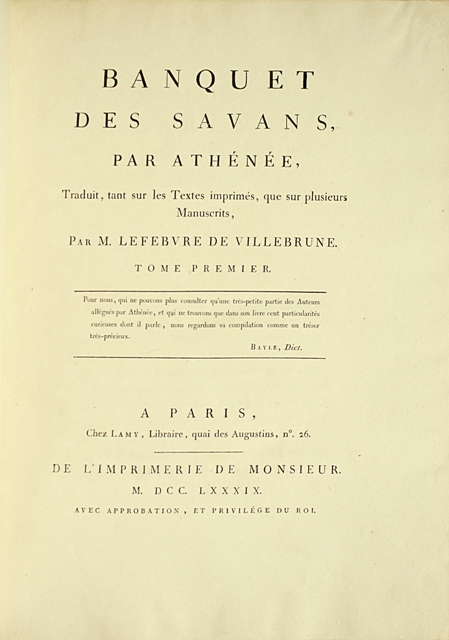Paris, Lamy (de l’imprimerie de Didot jeune), 1789-1791.
5 large 4to volumes [307 x 227 mm] of: I/ (3) ll., 504 pp., (2) ll.; II/ (2) ll., 537 pp. (misnumbered 503), (3) ll; III/ (1) bl.l., (2) ll., 565 pp. (misnumbered), (4) pp., (1) bl.l.; IV/ (1) bl.l., (2) ll., 561 pp., (4) pp.; V/ (2) ll., 562 pp. Full contemporary red morocco, gilt Greek pattern on the covers, inner gilt border, gilt edges. Contemporary binding.
First edition of the French translation by J.-B. Le Febvre de Villebrune of Athenaeus’ main work “Deipnosophistae” or the Authorities on banquets. Brunet, I, 536; Picot, Livres du Baron de Rothschild, II, 1901.
The work derives from the tradition of the “symposiac” genre, brilliantly illustrated by Plato’s Symposium and continued by Xenophon’s Symposium.
“If Plato and Xenophon had captured only one moment of the banquet, the libations (potos), Athenaeus, on the contrary, also captured what preceded it, that is the actual banquet (deipnon); but his presentation lacks of Plato’s theatrical authenticity and of Xenophon’s picturesque realism. The banquet takes place in Rome, during the “Parilia”: the erudite who take part discuss the most varied subjects; only politics isn’t brought up, because Athenaeus and his friends are surrounded by the “Pax romana” atmosphere and are all conformists. Despite its wordiness, the work is inestimably important; without it, entire chapters of Hellenic history and life would be missing and we would know even much less about the ancient and modern comedy. The “Deipnosophistae” are also part of the great tradition of the erudition of language, going from Aristarchus’ work to Suda’s one: their contribution in the vocabulary field is indeed very precious.” Maria Teresa Chianura.
The work is of course related to gastronomy by the amount of dishes described.
Beautiful copy, printed on large vellum, preserved in its contemporary decorated red morocco bindings.
See less information


